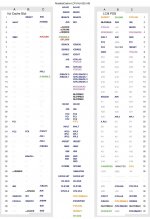Trash80toHP_Mini
NIGHT STALKER
. . . taken because I had a couple of days off with nothing in particular planned. That fresh look/blank page approach to the PowerCache Cloning Project seemed a good way to clear some of the cobwebs out. I decided that nice clean columns of text for pinouts of the various slots involved done to the same scale would come in handier than scrambling around looking for them in whatever size I'd done them across a slew of Illustrator files. Didn't turn out exactly as I imagined it, but it's a good start.

RosettaCache-00-003.PDF
I couldn't believe how few control lines were on the IIci Cache Slot, but luckily an error on my part sent me off to find four more. The 1990 PaparDocs were different from the 1989 Macintosh IIci DevNote. Four signals went undocumented as "n.c." for about a year. Dunno if it was done on purpose or what, but leaving CPU Disable undocumented outside the later Printed Volumes might well have been. Some line designations were changed from Vcc to +5V and some not. Why was the distinction between the two in the hard copy docs?
Signal nomenclature in the DevNote was XXXX~ and was changed to /XXXX matching earlier editions of Cards and Drivers and Hardware Guides. No clue what was up with that, but I found it odd.

DCaDftMF2e-vs-IIci_DevNote.PDF
I've got the passive LCIII Adapter in hand to translate into IIci Cache as a model for translating IIsi PDS passively into IIci Cache in the same manner. Why? Because I'm guessing my PowerCache Card might work just fine in a passive IIsi adapter, so long as there's nothing on the bus identifying itself as being located at Slot ID $E.
DayStar's drivers might check for the Mac's Identity, but I'm figuring not. We shall see.
edit: oopsie in the title, please fix. Looks like I failed to gray out A1 and a Vcc connection on the IIci Slot, still looks really bare to me, without those four n.c./undocumented signals grayed out the IIci Cache Slot looked all but naked.
Also: if I still had my IIx from back in the day and could find that blasted (passive) IIcx PowerCache adapter I'd be trying that combo with NuBus Slot $E empty.

RosettaCache-00-003.PDF
I couldn't believe how few control lines were on the IIci Cache Slot, but luckily an error on my part sent me off to find four more. The 1990 PaparDocs were different from the 1989 Macintosh IIci DevNote. Four signals went undocumented as "n.c." for about a year. Dunno if it was done on purpose or what, but leaving CPU Disable undocumented outside the later Printed Volumes might well have been. Some line designations were changed from Vcc to +5V and some not. Why was the distinction between the two in the hard copy docs?
Signal nomenclature in the DevNote was XXXX~ and was changed to /XXXX matching earlier editions of Cards and Drivers and Hardware Guides. No clue what was up with that, but I found it odd.

DCaDftMF2e-vs-IIci_DevNote.PDF
I've got the passive LCIII Adapter in hand to translate into IIci Cache as a model for translating IIsi PDS passively into IIci Cache in the same manner. Why? Because I'm guessing my PowerCache Card might work just fine in a passive IIsi adapter, so long as there's nothing on the bus identifying itself as being located at Slot ID $E.
DayStar's drivers might check for the Mac's Identity, but I'm figuring not. We shall see.
edit: oopsie in the title, please fix. Looks like I failed to gray out A1 and a Vcc connection on the IIci Slot, still looks really bare to me, without those four n.c./undocumented signals grayed out the IIci Cache Slot looked all but naked.
Also: if I still had my IIx from back in the day and could find that blasted (passive) IIcx PowerCache adapter I'd be trying that combo with NuBus Slot $E empty.
Attachments
Last edited by a moderator:

